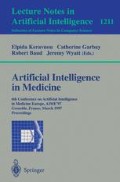Abstract
In this paper we introduce a novel approach for diagnosis and monitoring of ulnar nerve lesions, affecting the coordination of movement of the ring and little finger of the human hand. Based on data generated by ultrasound measurements, we developed suitable preprocessing methods for automatic extraction of relevant features from the movement pattern to be examined. The partial absence of class information even for the pattern in the training set requires the use of unsupervised methods for the learning and class assignment procedures. For that reason, we use a new dynamic and hierarchic neural network for the analysis of the generated pattern vectors. The dynamically structured architecture of the network satisfies the special needs of this medical task, such as providing variable levels of generalization and efficient retrieval of similar cases.
Preview
Unable to display preview. Download preview PDF.
References
L. Breiman, J.H. Friedman, R.A. Olsen, and C.J. Stone. Classification and Regression Trees. Belmont, CA, Wadsworth, 1984.
P.W. Brandt and A. Hollister. Clinical Mechanics of the Hand. Mosby Year Book, 1993.
R.O. Duda and P.E. Hart. Pattern Classification and Scene Analysis. Wiley, 1973.
L. Fang, A. Jennings, W. X. Wen, K. Li, and T. Li. Unsupervised learning for neural trees. In Proceedings of the IJCNN, 1991.
B. Fritzke. Growing cell structures — a self-organizing network for unsupervised and supervised learning. Technical Report TR-93-026, ICSI, 1993.
U. Guggenbühl and H. Krüger. Bewegungsanalyse an verschiedenen industriellen Arbeitsplätzen. Sozial-und Präventivmedizin, 32:266–268, 1987.
P. Hahn, H. Krimmer, A. Hradetzky, and U. Lanz. Quantitative analysis of the linkage between the interphalangeal joints of the index finger. in vivo study. Journal of Hand Surgery, 20B:696–699, 1995.
T. Kohonen. The self-organizing map. Proceedings of the IEEE, 78(9):1464–1480, 1990.
T. Li, L. Fang, and A. Jennings. Structurally adaptive self-organizing neural trees. In Proc. of the ICNN, 1992.
J. W. Littler and J. S. Thompson. Surgical and functional anatomy. In W.H. Bowers, editor, The interphalangeal joints, pages 14–20. Churchill Livingstone, Edinburgh, 1987.
Thomas Martinetz and Klaus Schulten. Topology representing networks. Neural Networks, 7(2), 1994.
J.R. Quinlan. C4-5: Programs for Machine Learning. Morgan Kaufman, 1993.
J. Rahmel. On the Role of Topology for Neural Network Interpretation. In W. Wahlster, editor, Proc. of the ECAI, 1996.
J. Rahmel. SplitNet: Learning of Hierarchical Kohonen Chains. In Proc. of the ICNN '96, Washington, 1996.
J. Rahmel and T. Villmann. Interpreting Topology Preserving Networks. Technical Report LSA-96-01E, University of Kaiserslautern, 1996.
H. Srinivasan. Universe of finger postures and finger dynamography. Handchir. Mikrochir. Plastische Chirugie, 15:3–6, 1983.
P. Utgoff. Perceptron trees: A case study in hybrid concept representations. In Proc. of the Nat. Conf. on AI, pages 601–606, St. Paul, MN, 1988.
Th. Villmann, R. Der, M. Herrmann, and Th. Martinetz. Topology preservation in self-organizing feature maps: Exact definition and measurement. IEEE Transactions on Neural Networks, 1996. To appear.
Author information
Authors and Affiliations
Editor information
Rights and permissions
Copyright information
© 1997 Springer-Verlag Berlin Heidelberg
About this paper
Cite this paper
Rahmel, J., Blum, C., Hahn, P., Krapohl, B. (1997). Diagnosis and monitoring of ulnar nerve lesions. In: Keravnou, E., Garbay, C., Baud, R., Wyatt, J. (eds) Artificial Intelligence in Medicine. AIME 1997. Lecture Notes in Computer Science, vol 1211. Springer, Berlin, Heidelberg. https://doi.org/10.1007/BFb0029453
Download citation
DOI: https://doi.org/10.1007/BFb0029453
Published:
Publisher Name: Springer, Berlin, Heidelberg
Print ISBN: 978-3-540-62709-8
Online ISBN: 978-3-540-68448-0
eBook Packages: Springer Book Archive

